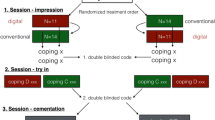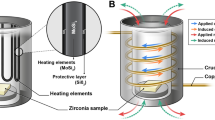Abstract
Objectives
To compare the fit of all-ceramic crowns fabricated from conventional silicone impressions with the fit of all-ceramic crowns fabricated from intraoral digital impressions.
Methods
Thirty patients with 30 posterior teeth with a prosthetic demand were selected. Zirconia-based ceramic crowns were made using an intraoral digital impression system (Ultrafast Optical Sectioning technology) (digital group, D) and 2-step silicone impression technique (conventional group, C).
To replicate the interface between the crown and the preparation, each crown was cemented on its corresponding clinical preparation using ultra-flow silicone. Each crown was embedded in resin to stabilize the registered interface. Specimens were sectioned in buccolingual orientation, and internal misfit was measured at different areas using stereomicroscopy (×40).
Data was analysed using Student’s t test and Mann-Whitney test (α = 0.05).
Results
No statistically significant differences were found (P > 0.05) between two groups. The mean internal misfit and mean marginal misfit were 170.9 μm (SD = 119.4)/106.6 μm (SD = 69.6) for group D and 185.4 μm (SD = 112.1)/119.9 μm (SD = 59.9) for group C.
Conclusion
Ceramic crowns fabricated using an intraoral scanner are comparable to elastomer conventional impressions in terms of their marginal and internal fits. The mean marginal fit in both groups was within the limits of clinical acceptability.
Clinical significance
Impressions based on Ultrafast Optical Sectioning technology can be used for manufacturing ceramic crowns in a normal workflow, with the same results as silicone conventional impressions.



Similar content being viewed by others
References
Gardner F (1982) Margins of complete crowns-literature review. J Prosthet Dent 48:396–400
Hunter A, Hunter AR (1990) Gingival margins for crowns: a review and discusion II. Discrepancies and configurations. J Prosthet Dent 64:636–642
Beuer F, Aggstaller H, Richter J, Edelhoff D, Wolfgang G (2009) Influence of preparation angle on marginal and internal fit of CAD/CAM fabricated zirconia crowns copings. Quintessence Int 40:243–250
Contrepois M, Soenen A, Bartala M, Laviole O (2013) Marginal adaptation of ceramic crowns: a systematic review. J Prosthet Dent 110:447–454 e10. doi:10.1016/j.prosdent.2013.08.003
Martinez-Rus F, Suarez MJ, Rivera B, Pradies G (2011) Evaluation of the absolute marginal discrepancy of zirconia-based ceramic copings. J Prosthet Dent 105:108–114. doi:10.1016/S0022-3913(11)60009-7
Sailer I, Fehér A, Filser F, Gauckler LI, Lüthy H, Hämmerle CH (2007) Five-year clinical results of zirconia frameworks for posterior fixed partial dentures. Int J Prosthodont 20:383–388
KL K, Campbell CS (2000) Periodontal tissue responses after insertion of artificial crowns and fixed partial dentures. J Prosthet Dent 84:492–498
Mitchell CA, Pintado MR (2001) Nondestructive, in vitro quantification of crown margins. J Prosthet Dent 85:575–584
Reich S, Wichmann M, Nkenke E (2005) Clinical fit of all-ceramic three-unit fixed partial dentures, generated with three different CAD/CAM systems. Eur J Oral Sci 113:174–179
Reich S, Kappe K, Teschner H, Schimitt J (2008) Clinical fit of four-unit zirconia posterior fixed dental prostheses. Eur J Oral Sci 116:579–584
Kohorst P, Brinkmann H, Li J, Borchers L, Stiesch M (2009) Marginal accuracy of four-unit zirconia fixed dental prostheses fabricated using different computer-aided manufacturing systems. Eur J Oral Sci 117:319–325
McLean J, Von Fraunhofer JA (1971) The estimation of cement film thickness by an in vitro technique. Br Dent J 13:107–111
Al-Bakri IAHD, Al-Omari WM (2007) The dimensional accuracy of four impression techniques with the use of addition silicone impression materials. J Clin Dent 18:29–33
Beuer F, Edelhoff D, Schweiger J (2008) Digital dentistry: an overview of recent developments for CAD/CAM generated resto- rations. Br Dent J 204:505–511
JEK A e S, Edelhoff D, Stimmelmayr M, Güth JF (2014) Marginal internal fit of four-unit zirconia fixed dental prostheses based on digital and conventional impression techniques. Clin Oral Invest 18:515–523
Birnbaum NS, Aaronson HB (2008) Dental impression using 3D digital scanners: virtual becomes reality. Compend Contin Educ Dent 29:494–505
Christensen GJ (2008) Will digital impressions eliminate the cur- rent problems with conventional impressions? J Am Dent Assoc 139:761–763
Suárez M, González de Villaumbrosia P, Pradíes G, Lozano J (2003) Comparison of the marginal fit Procera AllCeram crowns with two finish lines. Int J Prosthodont 16:229–233
Conrad H, Seong WJ, Pesun IJ (2007) Current ceramic materials and systems with clinical recommendations: a systematic review. J Prosthet Dent 98:389–404
Syrek A, Reich G, Ranftl D, Klein C, Cerny B, Brodesser J (2010) Clinical evaluation of all-ceramic crowns fabricated from intraoral digital impressions based on the principle of active wavefront sampling. J Dent 38:553–559. doi:10.1016/j.jdent.2010.03.015
Duret F (1996) CAD/CAM in dentistry: present and future applications. In current concepts. Quintessence Int 27:433–436
Schaefer O, Decker M, Wittstock F, Kuepper H, Guentsch A (2014) Impact of digital impression techniques on the adaption of ceramic partial crowns in vitro. J Dent 42:677–683
Seelbach P, Brueckel C, Wöstmann B (2013) Accuracy of digital and conventional impression techniques and workflow. Clin Oral Invest 17:1759–1764. doi:10.1007/s00784-012-0864-4
Logozzo S, Zannetti EM, Franceschini G (2014) Recent advances in dental optics. Part I: 3D intraoral scanners for restorative dentistry. Opt Lasers Eng 54:203–221
Wismeijer D, Mans R, Van Genuchten M, Reijers HA (2014) Patients’ preferences when comparing analogue implant impressions using a polyether impression material versus digital impressions (intraoral scan) of dental implants. Clin Oral Impl Res 25:1113–1118
Yuzbasioglu E, Kurt H, Turunc R, Bilir H (2014) Comparison of digital and conventional impression techniques: evaluation of patients’ perception, treatment comfort, effectiveness and clinical outcomes. BMC Oral Health 14
Fasbinder DJ (2010) Innovation for restorative treatment. Compend Contin Educ Dent 31:2–11
Brawek SW, Wolfarts S, Endres L, Kirsten A, Reich S (2013) The clinical accuracy of single crowns exclusively fabricated by digital workflow—the comparison of two systems. Clin Oral Invest 17:2119–2125. doi:10.1007/s00784-013-0923-5
Ender A, Melh A (2013) Influence of scanind strategies on the accuracy of digital intraoral scanning systems. Int Comput Dent 16:11–21
Martins LM, Lorenzoni FC, Melo AO, Silva LM, Oliveira JL, Oliveira PC, et al. (2012) Internal fit of two all ceramic systems and metal ceramic crowns. J App Oral Sci 20:235–240
Tsitrou EA, Northeast SE, Van Noort R (2007) Evaluation of the marginal fit of three margin designs of resin composite crowns using CAD-CAM. J Dent 35:68–73
Wettstein F, Sailer I, Roos M, Hämmerle CH (2008) Clinical study of the internal gaps of zirconia and metal frameworks for fixed partial dentures. Eur J Oral Sci 116:272–279
Souza ROA, Özcan M, Pavanelli CA, Buso L, Lombardo GH, Michida SM, Mesquita AM, Bottino MA (2012) Marginal and internal discrepancies related to margin design of ceramic crowns fabricated by a CAD-CAM system. J Prosthodont 21:94–100
Laurent M, Scheer P, Dejou J, Laborde G (2008) Clinical evaluation of the marginal fit of cast crowns validation of the silicone replic method. J Oral Rehabil 35:116–122
Reich S, Uhlen S, Gozdowski S, Lohbauer U (2011) Measurement of cement thickness under lithium disilicate crowns using an impression material technique. Clin Oral Invest 15:521–526
Pradíes G, Zarauz C, Valverde A, Ferreiroa A, Martínez-Rus F (2015) Clinical evaluation comparing the fit of all-ceramic crowns obtained from silicone and digital intraoral impressions based on wavefront sampling technology. J Dent Feb 43:201–208
Holmes JR, Bayne SC, Holland GA, Sulik W (1989) Considerations in measurement of marginal fit. J Prosthet Dent:405–408
Boeddinghaus M, Breloer ES, Rehmann P, Wöstmann B (2015) Accuracy of single-tooth restorations based on intraoral digital and conventional impressions in patients. Clin Oral Invest 19(8):2027–2034
Keul C, Stawarczy B, Erdelt KJ, Beuer F, Edelhoff D, Guth JF (2014) Fit of 4-unit FDPs made of zirconia and CoCr-alloy after chairside and labside digitalization-a laboratory study. Dent Mater J 30:400–407
Euán R, Figueras-Álvarez O, Cabratosa-Temes J, Oliver-Parra R (2014) Marginal adaptation of zirconium dioxide copings: influence of the CAD/CAM system and the finish line design. J Prosthet Dent 112:155–162
Ng J, Ruse D, Wyatt C (2014) A comparison of the marginal fit of crowns fabricated with digital and conventional methods. J Prosthet Dent 112:555–560
Fahmy NZ (2011) Influence of veneering materials on the marginal fit and fracture resistance of an alumina core system. J Prosthodont 20:45–51
Ferreira Quintas A, Oliveira F, Bottino MA (2004) Vertical marginal discrepancy of ceramic copings with differents ceramic materials, finish lines, and luting agents: an in vitro evaluation. J Prosthet Dent 92:250–257
Beuer F, Naumann M, Gernet W, Sorensen JA (2009) Precision of fit: zirconia three-unit fixed dental prostheses. Clin Oral Invest 13:34–39
Grenade C, Mainjot A, Vanheusden A (2011) Fit of single tooth zirconia copings: comparison between vairous manufacuring processes. J Prosthet Dent 105:249–255
Acknowledgments
This project was partially supported by a grant from Phibo Dental Solutions S.L. This manuscript has not been published and is not consideration for publication elsewhere. All authors have approved the manuscript and agree with its submission.
Author information
Authors and Affiliations
Corresponding author
Ethics declarations
Conflict of interest
The authors declare that they have no conflict of interests.
Rights and permissions
About this article
Cite this article
Berrendero, S., Salido, M.P., Valverde, A. et al. Influence of conventional and digital intraoral impressions on the fit of CAD/CAM-fabricated all-ceramic crowns. Clin Oral Invest 20, 2403–2410 (2016). https://doi.org/10.1007/s00784-016-1714-6
Received:
Accepted:
Published:
Issue Date:
DOI: https://doi.org/10.1007/s00784-016-1714-6




